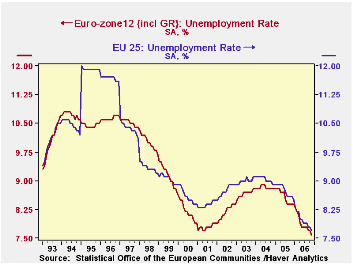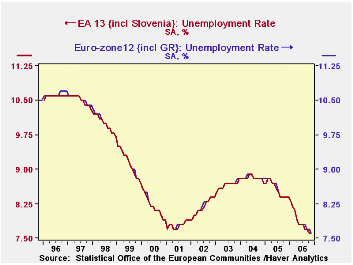 Global| Jan 05 2007
Global| Jan 05 2007European Union Unemployment Eases to New Lows; Supplemental Eurostat Series Include New Members
Summary
We've been impressed for some time with the evident strength in the European economy. Today, a summary of unemployment data for the entire region for November illustrates this well. The EU-12 group experienced 7.6% unemployment, down [...]

We've been impressed for some time with the evident strength in the European economy. Today, a summary of unemployment data for the entire region for November illustrates this well. The EU-12 group experienced 7.6% unemployment, down from 7.7% in October and the lowest rate recorded since this compilation began in 1993. The previous low was 7.7% during several months in early 2001, just as the tech boom was ending. In November 2005, the rate was 8.4% and the cycle high was 8.9% in the spring of 2004.
In the broader grouping, the EU-25, the current rate is remarkably similar, 7.7%. It too eased 0.1% in November, and it is down from 8.6% a year earlier. We are struck by how closely the broader region's unemployment rate has run to the smaller group's since 1997. The degree of industrialization and development doesn't automatically mean significantly lower unemployment, it seems.
Notably in this release, Eurostat has added data series covering its newly expanded membership. On January 1, Bulgaria and Romania joined the European Union and Slovenia became a member of the Euro-Zone, adopting the euro currency. So the EU25 becomes EU27 and Euro-zone12 becomes Euro-zone13. The "official" aggregates for European data, i.e., the "headline" series, remain the groups of 12 and 25 for purposes of aggregating data through 2006. These will shift to 13 and 27 when data for 2007 start to be reported. Even so, since Eurostat has begun to publish supplemental series for these new aggregates, Haver is adding a select number as temporary series. These, along with other Eurostat data, will be found in the EUROSTAT and G10 databases.
The new series look much like the old, and a quick glance at the three new member countries tells why. Slovenia, the new euro currency user, has lower-than-average unemployment that has declined sharply in the last year. In the wider group of now-27, Bulgaria and Romania both have rates that are presently close to the total, although that for Bulgaria has historically been considerably higher.
| Unemployment Rates (%, Month SA) |
Nov 2006 | Oct 2006 | Sept 2006 | Nov 2005 | 2005 | 2004 | 2003 |
|---|---|---|---|---|---|---|---|
| EA-12 | 7.6 | 7.7 | 7.7 | 8.4 | 8.6 | 8.8 | 8.7 |
| EU-25 | 7.7 | 7.8 | 7.8 | 8.6 | 8.8 | 9.1 | 9.0 |
| -- | -- | -- | -- | -- | -- | -- | |
| EA-13 | 7.6 | 7.6 | 7.7 | 8.4 | 8.6 | 8.8 | 8.7 |
| EU-27 | 7.7 | 7.8 | 7.8 | 8.5 | 8.7 | 9.1 | 9.0 |
| -- | -- | -- | -- | -- | -- | -- | |
| Slovenia | 5.6 | 5.6 | 5.7 | 6.9 | 6.5 | 6.3 | 6.7 |
| Bulgaria | 8.0 | 8.0 | 9.0 | 9.7 | 10.1 | 12.0 | 13.7 |
| Romania | -- | 7.9 | 7.7 | 6.9 | 7.2 | 8.1 | 7.0 |
Carol Stone, CBE
AuthorMore in Author Profile »Carol Stone, CBE came to Haver Analytics in 2003 following more than 35 years as a financial market economist at major Wall Street financial institutions, most especially Merrill Lynch and Nomura Securities. She has broad experience in analysis and forecasting of flow-of-funds accounts, the federal budget and Federal Reserve operations. At Nomura Securites, among other duties, she developed various indicator forecasting tools and edited a daily global publication produced in London and New York for readers in Tokyo. At Haver Analytics, Carol is a member of the Research Department, aiding database managers with research and documentation efforts, as well as posting commentary on select economic reports. In addition, she conducts Ways-of-the-World, a blog on economic issues for an Episcopal-Church-affiliated website, The Geranium Farm. During her career, Carol served as an officer of the Money Marketeers and the Downtown Economists Club. She has a PhD from NYU's Stern School of Business. She lives in Brooklyn, New York, and has a weekend home on Long Island.





